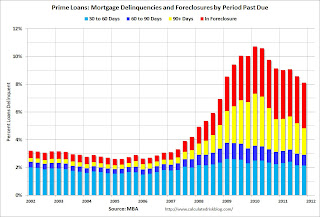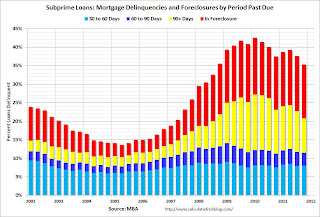by Calculated Risk on 2/20/2012 12:54:00 PM
Monday, February 20, 2012
Mortgage Delinquencies by Loan Type
By request, the following graphs show the percent of loans delinquent by loan type: Prime, Subprime, FHA and VA. First a table comparing the number of loans in 2007 and Q4 2011 so readers can understand the shift in loan types.
Both the number of prime and subprime loans have declined over the last four years; the number of subprime loans is down by about one-third. Meanwhile the number of FHA loans has increased sharply.
Note: There are about 49 million total first-lien loans - the MBA survey is about 88% of the total.
| MBA National Delinquency Survey Loan Count | ||||
|---|---|---|---|---|
| Q2 2007 | Q4 2011 | Change | Q4 2011 Seriously Delinquent | |
| Prime | 33,916,830 | 30,660,085 | -3,256,745 | 1,631,117 |
| Subprime | 6,204,535 | 4,178,732 | -2,025,803 | 1,017,521 |
| FHA | 3,030,214 | 6,611,396 | 3,581,182 | 596,348 |
| VA | 1,096,450 | 1,442,416 | 345,966 | 69,813 |
| Survey Total | 44,248,029 | 42,892,629 | -1,355,400 | 3,314,799 |
 Click on graph for larger image.
Click on graph for larger image.First a repeat: This graph shows the percent of loans delinquent by days past due. Loans 30 days delinquent increased to 3.22% from 3.19% in Q3. This is at about 2007 levels. Delinquent loans in the 60 day bucket decreased to 1.25% from 1.30% in Q4. This is the lowest level since Q4 2007.
There was a decrease in the 90+ day delinquent bucket too. This decreased to 3.11% from 3.50% in Q3 2011. This is the lowest level since 2008, but still way above normal (probably around 1% would be normal). The percent of loans in the foreclosure process declined slightly to 4.38% from 4.43%.
Note: Scale changes for each of the following graphs.
 The second graph is for all prime loans.
The second graph is for all prime loans. This is the key category now ("We are all subprime!", Tanta).
Since there are far more prime loans than any other category (see table above), about half the loans seriously delinquent now are prime loans - even though the overall delinquency rate is lower than other loan types.
 This graph is for subprime. This category gets most of the attention - mostly because of all the terrible loans made through the Wall Street "originate-to-distribute" model and sold as Private Label Securities (PLS). Not all PLS was subprime, but the worst of the worst loans were packaged in PLS.
This graph is for subprime. This category gets most of the attention - mostly because of all the terrible loans made through the Wall Street "originate-to-distribute" model and sold as Private Label Securities (PLS). Not all PLS was subprime, but the worst of the worst loans were packaged in PLS.Although the delinquency rate is still very high, the number of subprime loans has declined sharply.
 This graph is for FHA loans. The delinquency rate increased in Q4. Most of the FHA loans were made in the last few years, not in the 2004 to 2006 period like subprime - but as those loans season, the delinquency rate is expected to increase.
This graph is for FHA loans. The delinquency rate increased in Q4. Most of the FHA loans were made in the last few years, not in the 2004 to 2006 period like subprime - but as those loans season, the delinquency rate is expected to increase.The earlier improvement was a combination of the increase in number of loans (recent loans have lower delinquency rates) and eliminating Downpayment Assistance Programs (DAPs). These were programs that allowed the seller to give the buyer the downpayment through a 3rd party "charity" (for a fee of course). The buyer had no money in the house and the default rates were absolutely horrible.
 The last graph is for VA loans. This is a fairly small category (see table above).
The last graph is for VA loans. This is a fairly small category (see table above).There are still quite a few subprime loans that are in distress, but the real keys are prime loans and FHA loans.


